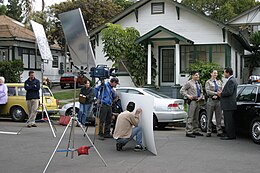| Revision as of 14:45, 8 December 2024 editHippo43 (talk | contribs)Extended confirmed users22,306 edits rm unsourced, non RS, undue weight← Previous edit | Revision as of 14:48, 8 December 2024 edit undoHippo43 (talk | contribs)Extended confirmed users22,306 edits rm undue weightNext edit → | ||
| Line 16: | Line 16: | ||
| *It may incorporate motion video with sound, computer animations, stills, and other digital media. | *It may incorporate motion video with sound, computer animations, stills, and other digital media. | ||
| *Capture of content may include use of cell phone integrated cameras and extend to commercial high-definition Broadcast quality cameras. | *Capture of content may include use of cell phone integrated cameras and extend to commercial high-definition Broadcast quality cameras. | ||
| The primary purpose of using video in distance education is to improve understanding and comprehension in a synchronous or asynchronous manner.<ref name="moore2012">Moore, M. G., & Kearsley, M. G. (2012). 'Distance education: A systems view of on line learning'. (3rd ed.). Belmont, CA: Wadsworth/Cengage Learning.</ref> | |||
| ] is also being used in education for distance learning projects; one innovative use was the ''DiveLive'' programs.<ref>{{cite web|url=http://digital.ncdcr.gov/cdm/ref/collection/p249901coll22/id/695248|title=Live from Morehead City, it's Queen Anne's Revenge|work=ncdcr.gov}}</ref> | ] is also being used in education for distance learning projects; one innovative use was the ''DiveLive'' programs.<ref>{{cite web|url=http://digital.ncdcr.gov/cdm/ref/collection/p249901coll22/id/695248|title=Live from Morehead City, it's Queen Anne's Revenge|work=ncdcr.gov}}</ref> | ||
| For example, ] details an exploration of a notable shipwreck: <blockquote>"In the fall of 2000 Rick Allen's Nautilus Productions co-produced with Bill Lovin of Marine Grafics a groundbreaking, week long live internet broadcast known as ''QAR DiveLive'' from the ] wreck site. For the first time ever, live video and audio was broadcast from an underwater archaeological site to the ]. Students were able to watch the ] in real time and ask questions of the scientists exploring the ]. The twice-daily live distance learning programs reached an estimated 1600 students from as far away as Canada during the five days of broadcasting. In October of 2001 Allen and Lovin again co-produced ''QAR DiveLive 2001''. This time the interactive webcasts from the seafloor and conservation laboratories of the '']'' Shipwreck Project reached over 3600 students and another 2700 remote viewers from fifteen states and 2 countries during the five days of broadcasts."<ref>{{cite web|title=Queen Anne's Revenge|url=http://nautilusproductions.com/archaeology|website=Nautilus Productions}}</ref></blockquote> | |||
| ==Internet video production== | ==Internet video production== | ||
Revision as of 14:48, 8 December 2024
Process of producing video content| This article may need to be rewritten to comply with Misplaced Pages's quality standards. You can help. The talk page may contain suggestions. (August 2020) |
}} Video production is the process of producing video content. It is the equivalent of filmmaking, but with video recorded either as analog signals on videotape, digitally in video tape or as computer files stored on optical discs, hard drives, SSDs, magnetic tape or memory cards instead of film stock.
Television broadcast
Main article: Broadcast See also: Television studio
Two styles of producing video are ENG (Electronic news-gathering) and EFP (Electronic field production).
Video production for distance education
Video production for distance education is the process of capturing, editing, and presenting educational material specifically for use in on-line education. Teachers integrate best practice teaching techniques to create scripts, organize content, capture video footage, edit footage using computer based video editing software to deliver final educational material over the Internet. It differs from other types of video production in at least three ways:
- It augments traditional teaching tools used in on-line educational programs.
- It may incorporate motion video with sound, computer animations, stills, and other digital media.
- Capture of content may include use of cell phone integrated cameras and extend to commercial high-definition Broadcast quality cameras.
Webcasting is also being used in education for distance learning projects; one innovative use was the DiveLive programs.
Internet video production
Main article: Internet videoIncreasing internet speeds, the transition to digital from physical formats such as tape to file-based media and the availability of cloud-based video services has increased use of the internet to provision services previously delivered on-premise in the context of commercial content creation for example video editing. In some cases the lower costs of equivalent services in the cloud has driven adoption and in others the greater scope for collaboration and time savings.
Individual Internet marketing videos are primarily produced in-house and by small media agencies, while a large volume of videos are produced by big media companies, crowdsourced production marketplaces, or in scalable video production platforms.
See also
References
- Medoff, Norman; Fink, Edward J. (2012-09-10). Portable Video: ENG & EFP. CRC Press. ISBN 978-1-136-04770-1.
- Cite error: The named reference
moore2012was invoked but never defined (see the help page). - "Live from Morehead City, it's Queen Anne's Revenge". ncdcr.gov.
- "Will facilities ever go completely cloud-based". 26 February 2018.
- Price, Allison (15 June 2015). "Shifting Gears: How cloud is revolutionizing TV post-production".
- "The Advantages of Individual Marketing". Retrieved 31 May 2019.
External links
 Media related to Video productions at Wikimedia Commons
Media related to Video productions at Wikimedia Commons